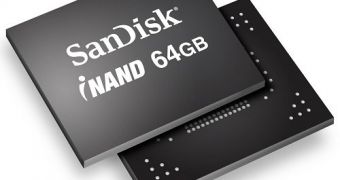The e.MMC 4.4 standard interface is designed for embedded storage devices that are made up of NAND flash memory and a flash memory controller. This specification aims to provide a flexible data storage solution and program code for mobile electronics devices. SanDisk's iNAND embedded flash drives, however, claim to exceed this specification by offering unique features that improve system responsiveness and “bridge the gap between e.MMC’s plain boot solution and its practical implementation.“
The iNAND EFDs “accelerate the implementation of consolidated boot and storage code within a single device.” The 64GB model is the newest in the line and uses the company's 3-bit-per-cell (X3) NAND Flash chips. All the drives offer flexible read prioritization functionality. This feature bestows upon the EFD the ability to temporarily suspend certain operations in order to better run those of higher priority, reducing latency. The iNAND further reduces system latency by performing common flash maintenance operations in the background when the device is idle. Such operation can be scheduled by the host, making sure that the device is not busy when it is needed.
"The maturity of SanDisk's X3 flash technology together with innovations in flash management are what allow us to continue making higher embedded storage capacities, such as 64GB, a practical solution in the market," said Oded Sagee, director, mobile product marketing, SanDisk. "We understand the highly competitive environment in which our customers operate. By leveraging the substantial experience gained with our X3 NAND and significant advancements made in flash management technology, we offer our customers a very high return on their investment."
This balance between system code and user data storage is possible thanks to the fact that the NAND architecture is divided into a cost-effective, high-sequential performance area (for the storage) and a random performance area (for the smartphone operating system). This architecture was developed after in-depth analyses of smartphone usage and “supports highly aggressive mobile system and usage scenarios.”
The iNAND embedded flash drives combine this feature set with a power efficient package that leaves a small environment footprint. SanDisk is demonstrating the technology at the Mobile World Congress (MWC) in Barcelona, Spain.

 14 DAY TRIAL //
14 DAY TRIAL //